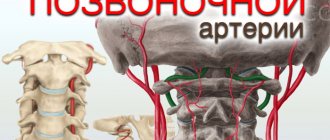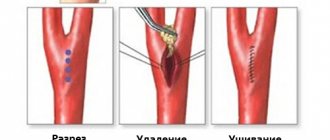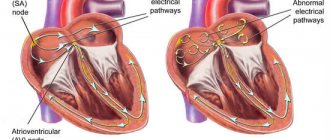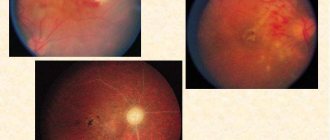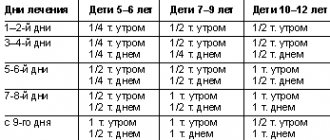Vertebral artery syndrome (VAS) is not a separate disease. It can be observed in a number of different pathologies, in which there is a narrowing of the lumen of one or two vertebral arteries, deformation of the walls and irritation of the nerves located nearby. As a result, the blood supply to certain parts of the brain is disrupted, which leads to a deterioration in their performance, sometimes to the point of critical conditions. In such situations, patients may suffer from persistent migraines, various visual and hearing impairments, loss of consciousness or a stroke. As a result, irreversible changes in the brain can occur, which can result in disability or even death.
Vertebral artery syndrome is a collective term that can be used to describe the clinical picture of many diseases that are fundamentally different in the cause of development, including cervical migraine or Barre-Lieu syndrome, arterial hypoplasia, vertebrobasilar insufficiency, provoked by cervical osteochondrosis, etc.
Vertebral artery compression syndrome is included in the International Classification of Diseases (ICD-10), where it is assigned code G99.2. This allowed doctors to widely use this term when describing a number of diseases and at the same time gave rise to lively discussions in medical circles about the advisability of its use when making a diagnosis, since SPA is nothing more than a complex of symptoms, and the causes of its occurrence can be very diverse.
Anatomy of the vertebrobasilar region and the mechanism of development of SPA
Two vertebral arteries originate in the upper part of the chest, pass through the lumen of the 6th cervical vertebra and rise strictly vertically through similar natural openings in the overlying cervical vertebrae. In the area of the occipital opening they merge into a single vessel called the basilar artery.
Therefore, vertebral artery syndrome can occur both against the background of the development of systemic vascular pathologies, and as a result of damage to the anatomical structures surrounding these blood vessels, i.e. connective tissue formations, muscles, nerves, vertebrae.
The two vertebral arteries and the basilar artery form the vertebrobasilar basin. They provide 15-30% of the blood supply to the brain. These arteries are responsible for the blood supply:
- the spinal cord passing at the level of the cervical spine;
- cerebellum;
- inner ear;
- posterior lobes of the thalamus and hypothalamus;
- midbrain and medulla oblongata;
- certain parts of the temporal and occipital lobes of the brain.
Therefore, if blood flow in the vertebral arteries is disrupted, regardless of the causes and location of the narrowing or blockage of their lumen, the listed parts of the spinal cord and brain experience a deficiency of oxygen and nutrients. This leads to the appearance of manifestations characteristic of SPA in the form of dizziness, pain of varying degrees of intensity, tinnitus, impaired coordination of movements, loss of consciousness, etc.
During vertebral artery syndrome there are 2 stages:
- Functional or dystonic - the initial stage of the development of SPA, at which the emerging manifestations of circulatory disorders mainly consist of the appearance of headaches of a burning, aching or pulsating nature, dizziness, unsteadiness of gait, visual disturbances in the form of darkening in the eyes, signs of photopsia. Most often, such symptoms are paroxysmal in nature and appear when the head is held in a forced position for a long time or there is a sudden movement. If this is accompanied by strong and prolonged spasms of the arteries, the disease leads to the formation of persistent foci of cerebral ischemia, which indicates the transition of SPA to the second stage of development.
- Organic or ischemic - accompanied by the occurrence of persistent disturbances in the blood supply to brain tissue, which leads to severe headaches, dizziness, reflexively causing nausea and vomiting, as well as serious disturbances in coordination, orientation in space, speech and other severe disorders. With a sudden movement, a person may suddenly fall while in the creation or lose it. An improvement in the condition is observed after taking a horizontal position.
Photopsia is a condition in which bright spots, spots, and sparks appear before the eyes.
Causes and prevalence of pathological tortuosity
Pathological tortuosity always develops due to the elongation of the internal carotid artery, which is forced to fold into bends or even loops. Excessive length of the internal carotid artery is often formed during embryonic development, that is, the tortuosity of the artery is most often congenital. With age, further twisting of the redundant carotid artery into a loop may occur. According to some researchers, pathological tortuosity may be the cause of neurological and intellectual problems in children of preschool and primary school age.
Lengthening of the internal carotid artery can also develop as a result of advanced hypertension, when constantly elevated blood pressure causes changes in the artery wall and its bends. Such tortuosity rarely affects cerebral hemodynamics and is more often a phenomenon detected incidentally by ultrasound of the great arteries.
Pathological tortuosity of the carotid arteries was detected in 16% of patients who died from ischemic stroke; more than 23% of children who suffered an ischemic stroke had pathological tortuosity. When examining patients undergoing treatment for cerebrovascular accidents, pathological tortuosity was detected by ultrasound angioscanning in 12%. Various disorders of the internal carotid arteries, according to pathological studies, were identified in 40% of people.
Causes of development of vertebral artery syndrome
SPA can occur against the background of a large number of diseases. All of them can be divided into 3 groups: congenital anomalies, vascular pathologies and vertebrogenic (spine-related) disorders. But in all cases, either compression of the blood vessels (stenosis) occurs by one or another anatomical structure or a decrease in their lumen, which leads to disruption of blood flow through them.
Most often, the vertebral arteries are compressed in the area of 5-6 cervical vertebrae, as they most often suffer from osteochondrosis, protrusions, intervertebral hernias, and spondylosis.
Most often, vertebral artery syndrome is a consequence of:
- Osteochondrosis of the cervical spine and its complications in the form of protrusions and herniations of intervertebral discs, as well as spondylosis. In such situations, a decrease in the height of the intervertebral discs is observed, which leads to disturbances in the anatomy of the spine and compression of one or both vertebral arteries by the approaching vertebrae or by bone outgrowths (osteophytes) formed on their edges.
- Pathological mobility of the cervical vertebrae, basilar impression, subluxation of the articular processes of the vertebrae, Powers and Kimmerly anomalies. In such cases, the vertebral arteries are displaced or compressed by spasmodic muscle fibers or abnormally located bone structures.
- Compression of the spinal roots. This is accompanied by reflex arterial stasis, i.e. stopping blood flow.
- Thrombosis and atherosclerosis of the vertebral arteries. These vascular pathologies lead to a narrowing of the lumen of the arteries as a result of the formation of blood clots or atherosclerotic plaques, the size of which directly affects the quality of blood flow. In some cases, the blood passage can be so weakened or completely blocked that a stroke results.
- Benign and malignant tumors located in close proximity to the vertebral arteries. They are also capable of mechanically compressing vessels and leading to corresponding circulatory disorders in the vertebrobasilar region.
In most cases, the left vertebral artery is affected, since it is in it that atherosclerotic plaques most often form, and developmental anomalies are more often observed on the left side.
Also, the reason for the development of SPA can be:
- fibromuscular dysplasia;
- tortuosity and the presence of kinks of the vertebral arteries;
- hypertension;
- systemic vasculitis;
- myofascial syndrome;
- scoliosis;
- spondylolisthesis, etc.
Surgical treatment and prevention of cerebral ischemia of extraranial origin
4.6 / 5 ( 5 votes)
"Surgical prevention of ischemic stroke in patients with diseases of the main arteries of the head and neck"
Introduction Vascular diseases of the brain are a pressing medical and social problem. Every year more than 6 million people suffer a stroke in the world, of which 400-450 thousand are registered only in Russia. Stroke is the absolute leading cause of disability in the population. Of all acute cerebrovascular accidents, 70% are ischemic stroke. In economically developed countries, a similar situation was observed several decades ago, but due to the implementation of preventive measures against atherosclerosis on a national scale in these countries, the situation has changed radically - mortality from cardiovascular causes has decreased by 2 times or more, and the average life expectancy of the population has sharply increased.
In population studies, about 50% of ischemic episodes, both permanent and temporary, are thrombotic or embolic complications of atherosclerosis of large and medium-sized arteries, about 25% are associated with diseases of small-diameter intracranial vessels, about 20% are associated with embolism from the heart, and the remaining 5% of episodes are associated with rarer causes (artery dissection, arteritis, blood diseases leading to hypercoagulability syndrome, etc.). Atherosclerotic lesions of arteries of large and medium diameter, appearing to be the most common cause of ischemic episodes, are the most significant object of surgical intervention or drug treatment aimed at preventing possible ischemic cerebral catastrophes.
Pathogenesis of atherothrombotic stroke.
Atheromatous plaques primarily affect large (aortic arch) and medium-sized arteries, especially at sites of division (bifurcation of the common carotid artery), tortuosity (siphon of the internal carotid artery (ICA)) or confluence (basic artery (BA). Intracranial arteries (distal to the circle of Willis ) suffer from atherosclerosis extremely rarely, in connection with this, occlusions of these arteries occur due to embolism more often than due to local thrombosis at the site of the atheromatous plaque. This distribution of atherosclerotic plaques is probably determined by the sites of hemodynamic stress and endothelial injury, border zones of separation flow and stagnation of blood and turbulence, which can cause thrombus formation, which in itself leads to the progression of atheromatous lesions. From the early stages of their formation, plaques are complicated by adhesion, activation and aggregation of platelets, which triggers coagulation and mural thrombosis. Atherothrombotic plaque can grow and clog the lumen arteries, then the thrombus in the arterial lumen spreads proximally or distally, the thrombus can undergo lysis through fibrinolytic mechanisms of the vascular wall and blood. The thrombus, or part of it, can become an embolus, leading to occlusion of the distal arteries. Thus, emboli are composed of a combination of cholesterol, platelet aggregates, and fibrin. Depending on their composition, size, density, and age, emboli may be lysed, fragmented, or continue to occlude the distal artery and possibly trigger local anterograde and retrograde thrombosis. It is likely that the nature and speed of local blood flow determine to some extent the fate of emboli. Whether cerebral infarction occurs or not depends on the adequacy of collateral blood flow. Emboli are transported to the brain or eye along the normal arterial blood supply, which itself varies from person to person. Thus, an embolus formed in the ICA usually enters the eye or the anterior two-thirds of the cerebral hemisphere, but can enter the occipital lobe through the posterior communicating artery (PCoA). Emboli can appear in more unusual places (for example, with severe damage to the vertebral arteries (VA) and low blood flow in the OA, an embolus formed in the ICA can reach the OA through the circle of Willis). The embolus may end up in the opposite hemisphere, reaching the latter through the anterior communicating artery (ACOA). Other “exotic” variants of embolic migration are also possible. Finally, ischemic stroke on the side of the occluded ICA may result from slow blood flow in the area of its supply or in the border zone, especially if the collateral blood supply is insufficient. Atherosclerotic damage to the arteries may not produce obvious clinical symptoms, nevertheless causing an undoubted danger of developing cerebral ischemic episodes in the future. According to these clinical features, patients with atherosclerosis of the main arteries of the head are conventionally divided into symptomatic and asymptomatic, respectively.
Carotid endarterectomy or drug prophylaxis? The first successful endarterectomy was performed in the USA in 1953. In subsequent decades, indications for carotid endarterectomy (CEA) have steadily expanded, and the number of operations performed has grown rapidly. For example, in 1985, the indications for performing CEA in the USA were as follows:
1. hemispheric TIA 2. transient monocular blindness 3. vertebrobasilar insufficiency 4. general hypoperfusion 5. stroke with minimal residual deficit 6. lesion or combination of lesions predisposing to stroke
The latter indication was, of course, a euphemism for asymptomatic carotid stenosis. Nonstenotic but severely ulcerated plaques at the carotid bifurcation in both symptomatic and asymptomatic patients have also been considered by many leading surgeons as a suitable indication for surgical treatment. At that time, the evaluation of virtually every patient candidate for CEA included conventional angiography, but standards for measuring the percentage of narrowing or diameter were not developed. It was widely believed that a 50% narrowing of the diameter resulted in a hemodynamically and therefore clinically significant effect predisposing to the development of stroke, thus amenable to surgical removal. In addition, most, if not all, surgeons accepted the premise that the risk of intraoperative hypotension in the presence of carotid stenosis was a particularly dangerous combination. As a result, asymptomatic carotid disease has been considered and treated prophylactically in patients undergoing cardiac or abdominal aortic surgery. With these indications, by 1985, CEA had become the most common peripheral vascular procedure performed in the United States, with more than 107,000 CEA performed at nonfederal medical centers that year. In the 60s of the last century, neurosurgeons at the N.V. Sklifosovsky Research Institute for Emergency Medicine were actively involved in the problem of diagnosis and surgical treatment of stenotic lesions of the main arteries of the head. This huge and steadily expanding number of operations has not escaped the attention of many leading neurologists. Articles began to appear on the effectiveness and safety of carotid surgeries in general and in asymptomatic patients in particular. Several significant reports highlighted potential flaws in presentations that supported the generally accepted indications for CEA. An important publication on this topic was Brott and Thalinger's review of all CEAs performed in Cincinnati, Ohio in 1984. They found an unexpectedly high operative morbidity and mortality rate (9.5%) and argued that these surgical outcomes are likely to be typical throughout the country, and if so, is there any benefit to CEA at all? Such concerns led to the design, initiation, and eventual execution of several randomized prospective clinical trials comparing the results of CEA with the best medical treatment available at the time in symptomatic and asymptomatic patients. Seven large studies conducted in North America and Europe included three in symptomatic patients and four in asymptomatic patients. All studies were multicenter, prospective, and randomized, but had different patient inclusion and exclusion criteria, different methods for measuring the degree of stenosis, and different methods for reporting results. Despite these differences, there was strong agreement in the important outcomes of all symptomatic studies and three of the four asymptomatic studies.
Large multicenter randomized prospective studies were devoted to comparison of the effectiveness of conservative and surgical prevention of ischemic stroke in patients with symptomatic carotid stenoses: North American Symptomatic Carotid Endarterectomy Trial (NASCET) and European Carotid Surgery Trial (ECST), etc. The mentioned studies compared the effectiveness of isolated conservative prevention with a combination of “surgical prevention + conservative prevention” in patients with varying degrees of carotid stenosis. Since quantitative indicators of carotid damage have become the main factor in the selection of patients for surgical treatment, before moving on to a brief description of the studies and their results, it is very important to discuss methods for measuring the degree of stenosis. The American method differs significantly from the European method. The American method was used with the Extracranial Arterial Occlusive Disease Study in the 1950s and continued to be used in the Veterans Administration (VA) Asymptomatic Trial, NASCET, and Asymptomatic Carotid Atherosclerosis Trial (ACAS). The method involves measuring the diameter of the lumen at the site of greatest stenosis (A) on angiography and comparing it with the diameter of the ICA distal to the stenosis, at the point where the walls of the ICA become parallel (B).
the degree of stenosis according to the European method involves presenting the hypothetical boundaries of the ICA bulb, the diameter of which (C) is normally greater than the lumen of the ICA. The degree of stenosis is calculated using the formula:
(1 – A/C)x100
The difference in numbers for the same stenosis is most pronounced with low degrees of stenosis and becomes minimal with severe stenosis.
This difference is presented in the table:
Randomized trials on the prevention of ischemic stroke in symptomatic patients. NASCET
The study was designed to test the hypothesis that symptomatic patients (with hemispheric or monocular TIAs or previous minor strokes) with ipsilateral carotid stenosis (30-99% by NASCET) would experience fewer fatal and nonfatal strokes after CEA and medical treatment than patients after isolated drug treatment. It was planned to enroll 3000 patients in the study and follow them for 5 years. Patients were divided into groups of severe (70-99%) and moderate (30-69%) stenoses. In the group of patients with severe stenoses, the study ended early: the cumulative two-year risk of any ipsilateral stroke in the medical group was 26%, and in the surgical group it was 9% (including perioperative surgical risk of stroke). The absolute risk reduction was 17% and the relative risk reduction was 65%. The risk of mortality in the groups was 12% and 5%, respectively. The relative reduction in mortality risk was 58%.
Effect of carotid endarterectomy on reducing the risk of stroke or death according to NASCET results
Patients with moderate stenoses (50-69%) showed a small but statistically significant benefit of CEA, while patients with minor stenoses (30-49%) showed no benefit of CEA. This overwhelming advantage in the group of severe stenoses was made possible due to the relatively low risk of surgery. Thus, the 30-day rate of “death + stroke” was 5.8%. It was also noted that the risk of stroke in the drug group was higher for every 10% increase in the degree of stenosis from 70 to 99. It was then noted that retinal TIAs had a less dire prognosis than hemispheric TIAs in the drug control group. So the probability of developing a stroke within 2 years in the group of “retinal” patients was 17%, and in the group of “hemispheric” patients - 44%. It was also noted that the presence of contralateral occlusion significantly worsened the prognosis of patients in the drug group. At two-year follow-up, 54.6% of such patients in the medical group suffered a stroke or died, while the same figure was only 20% in the surgical group. Patients enrolled in the study with a history of TIA but who had infarcts detected on brain CT showed an increased risk of developing ipsilateral stroke during follow-up (26% vs. 13%). In subsequent publications, NASCET investigators noted that the presence of plaque ulceration on angiography seriously complicates prognosis. Thus, the two-year risk of stroke in “medicated” patients with an ulcerated plaque increased from 26.3% to 73.2% with an increase in the degree of stenosis from 70% to 99%. Interestingly, the risk in patients without ulceration was 21.3%, regardless of the degree of stenosis. In addition, the operative risk did not change significantly in patients with and without ulceration. In February 1998, NASCET investigators reported results for patients with moderate stenoses. From the report it became clear that patients with 50-69% stenoses are preferable to undergo CEA (based on 5-year follow-up results). However, the difference, although statistically significant, was not as dramatic as in the severe stenosis group. In addition, the surgical risk in this group was higher and amounted to 6.7%. ECST Initiated in 1981, this randomized prospective study was conducted under the auspices of the Medical Research Council of GB. Patients were divided into three categories of stenosis: 0-29%, 30-69% and 70-99%, measured according to the European method. Overall, the 3-year risk of stroke in patients with severe stenosis (70-99%) was 21.9% in patients receiving medical therapy and 12.3% in patients after CEA. The absolute reduction in stroke risk was 9.6% and the relative reduction was 56%.
Three-year risk of stroke in the drug prevention group in patients with severe carotid stenosis:
In 1991, researchers reported their preliminary results, which coincided with the American ones. In the small stenosis group, the risk of stroke was small, and patients were recommended to undergo drug treatment. In the group of severe stenoses, despite the 30-day surgical risk of 7.5%, there was a six-fold reduction in the risk of stroke when using the surgical method of treatment. For 778 patients randomized to the severe stenosis group, CEA virtually eliminated the risk of ipsilateral stroke during follow-up. The table details the average annual risk of ipsilateral ischemic stroke following successful CEA.
In 1996, European researchers reported the results of an observation of a group with moderate stenoses. There was no significant advantage of the surgical treatment method. However, we should not forget about the significant difference between the methods for measuring the degree of stenosis between Europe and the USA.
Thus, both studies, although differing in tactical details, were unanimous in their strategic conclusions: with severe symptomatic stenoses, surgical prevention of ischemic stroke has undoubted (p
NASCET found a clear association between the number of risk factors and the rate of late stroke in the group of patients treated conservatively. A similar but less pronounced association was demonstrated in asymptomatic arteries.
ACST ACST is a more modern (and to date the largest) randomized trial on the choice of method for the prevention of ischemic stroke in asymptomatic patients. It was initiated and led by the Medical Research Council and the UK Stroke Association. 3120 patients with carotid stenosis ≥60% were randomized to surgery (50% CEA performed within 1 month, 88% within 1 year) or medical group. The average follow-up period was 3.4 years. Exclusion criteria were: high risk of surgical intervention, previously performed ipsilateral CEA, suspected cardiac embolism. The 5-year risk of stroke (including perioperative stroke) was 6.4% in the surgical group and 11.8% in the medical group. Risk rate for fatal or disabling stroke: 3.5% and 6.1%, respectively. Risk rate for fatal stroke: 2.1% and 4.2%, respectively. Two features were also revealed: the benefits of surgical prophylaxis were more pronounced in men; there was no statistically significant advantage of the surgical method of prevention in patients over 75 years of age. Thus, the results of ACAS and ACST revealed a significant (although less pronounced than in symptomatic patients) benefit of surgical prophylaxis in patients with asymptomatic carotid stenoses of 60-99%.
The nature of the atherosclerotic plaque is also a significant factor: heterogeneous, hypoechoic plaques increase the patient's risk of stroke.
Pathological tortuosity of the main arteries of the head. Acute and chronic cerebral circulatory failure can be caused not only by atherosclerotic stenosis, but also by the presence of kinks and loops of the internal carotid and (or) vertebral arteries. According to pathological studies, severe tortuosity of the carotid arteries was found in 30% of patients who died from ischemic stroke 1. Tortuosity of the carotid or vertebral artery with impaired blood flow and symptoms of acute or chronic cerebrovascular accident in the corresponding vascular area is considered pathological 2. Form of lengthening - Tortuosity - there are C and S-shaped bends of the arteries - Kinking - there are bends of the elongated arteries at an acute angle (angulation) - Coiling - there is elongation of the arteries in the form of loops and spirals. 3. Characteristics of bends - Without reducing the lumen - With a narrowing of the lumen at the bend - With the formation of partitions
A change in the course of the artery leads to noticeable hydrodynamic and hemodynamic disturbances: 1. In a bend, the local blood pressure at the artery section is minimal on the inner wall of the bend, progressively increases and reaches a maximum on the outer wall of the artery bend. 2. In inverse proportion to local pressure, the local speed of blood flow also changes (minimum at the outer radius and maximum at the inner radius). 3. Due to the difference in pressure (at the outer and inner radius), stable secondary flows of transverse and counter blood circulation arise, having the nature of a vortex. 4. A sharp sudden increase in pressure (especially during a hypertensive crisis) can lead to hydrodynamic blockage in the bend area. 5. The total energy losses during artery tortuosity are significant and, accordingly, increase with echelon tortuosities (the so-called S or Z-shaped tortuosities).
Conclusion.
Thus, today, carotid endarterectomy is indicated for patients with carotid stenoses of 70-99%. 1. asymptomatic patients with carotid stenosis of 60-99% 2. symptomatic patients with stenosis of the internal carotid artery more than 50%, tortuosity of the vertebral arteries, pathological tortuosity of the carotid arteries.
Indications for surgical treatment of pathological tortuosity of the brachiocephalic and vertebral arteries: 1. ischemic stroke or TIA in the territory of the tortuous artery; 2. CNM in the absence of the effect of conservative therapy and a decrease in the patient’s quality of life; 3. asymptomatic tortuosity in the presence of focal changes on CT scan of the brain; 4. stenosis > 60% at the site of artery bending and loop formation. 5. The difference in blood flow velocity in the tortuosity zone is 2 or more times according to Doppler ultrasound.
Indications for the operation of extra-intracranial microanastomosis (EICMA): 1. Occlusion of the carotid artery with a clinical picture of depletion of the cerebral perfusion reserve and decompensation of collateral circulation, manifested by transient ischemic attacks in the basin of the occluded internal carotid artery. 2. Hemodynamically significant stenosis of the middle cerebral artery and tandem stenoses. 3. As the first stage of surgical treatment before CEA for occlusion of the contralateral carotid artery.
Indications for reconstruction of the vertebral artery.
1. Patients with symptoms of unstable hemodynamics in the vertebrobasilar region: - With stenosis of the dominant vertebral artery more than 75%. - With a stenotic process of the same degree of stenosis of both vertebral arteries. — In case of segmental occlusion of the second segment of the vertebral artery in the presence of hypoplasia of the other. 2. Patients with a clinical picture of stem dyscirculation of thromboembolic origin, in which the source of the embolism from the vertebral artery has been identified. 3. With extravasal compression significantly affecting vertebral blood flow (cervical rib, Kimmerly's anomaly, uncovertebral arthrosis and other spondylogenic causes).
Methodology for carotid endarterectomy surgery.
At the moment, there are two main methods of performing carotid endarterectomy: 1. Classic carotid endarterectomy with the possible use of lateral expansion patch angioplasty. 2. Eversion carotid endarterectomy.
The use of one or another technique often depends on the personal preferences of the operating surgeon, but in some conditions each method has its own advantages and is most preferable in a particular clinical situation.
Classic carotid endarterectomy is most often performed for:
1. When the atherosclerotic plaque is localized in the common carotid artery, its bifurcation and at the mouth of the internal carotid artery without prolongation of the plaque to the proximal and middle third of the internal carotid artery. 2. If the diameter of the internal carotid artery is sufficient (4-5 mm), otherwise, without using an expanding patch, there is a high probability of postoperative restenosis of the internal carotid artery, which is most important in women. 3. With a high location of the bifurcation of the common carotid artery. 4. During classical carotid endarterectomy, arteriolysis along the posterior surface of the carotid group and removal of the carotid body are not required, which significantly reduces the duration of the operation and the risk of damage to the vessels located behind the internal and common carotid arteries - the ascending pharyngeal and carotid body arteries.
Eversion carotid endarterectomy is preferred:
1. In the presence of concomitant pathological tortuosity of the internal carotid artery, when, simultaneously with carotid endarterectomy, it is possible to perform redressing of the internal carotid artery with its reimplantation into the “former” mouth or a new mouth on the common carotid artery. 2. In the case of a prolonged atherosclerotic plaque, with its spread above the mouth of the internal carotid artery. 3. With a “narrow” internal carotid artery (diameter less than 3-4 mm) and a high risk of using an expanding lateral patch (patch suppuration in patients with diabetes mellitus).
Conditions for performing carotid endarterectomy surgery.
Most operations are performed under multicomponent endotracheal anesthesia, which significantly increases the body's resistance to hypoxia, and moderate controlled arterial hypertension is also used for this purpose. After clamping the carotid, blood pressure rises by an average of 20 mm. RT. Art. and equals approximately 140-160/90 mmHg. Systemic heparinization protects against thrombus formation in compressed arteries and reduces intraoperative embolism. The amount of heparin is administered at the rate of 100 U/kg of patient weight.
Scheme of the operation of classical carotid endaretrectomy.
Position the patient on his back with his head turned in the direction opposite to the operation. The incision line is projected along the anterior edge of the sternocleidomastoid muscle, starting from the mastoid process and ending 1-2 cm distal to the jugular notch. The skin, subcutaneous fascia, and subcutaneous muscle are dissected in layers. On the access route, the external jugular vein may be encountered, which is ligated and divided. The anterior edge of the sternocleidomastoid muscle is mobilized and retracted laterally using an Anderson-Edson retractor. As you move deeper into the wound, the lateral branch of the retractor is also inserted deeper, but the medial branch should not be deepened or moved, which can cause damage to the cartilage of the larynx. Immediately below the sternocleidomastoid muscle is the internal jugular vein with the common facial vein branching off from it - the key to the bifurcation of the common carotid artery. The common facial vein is divided and sutured, after which the internal jugular vein becomes mobile and is easily retracted externally. At this point, it is necessary to perform systemic heparinization and begin skeletonization of the carotid arteries. It is easiest to start from the lower corner of the wound, where the Common Carotid Artery is located. The carotid artery sheath is opened and dissection is performed in the longitudinal direction, which is safe. When approaching the bifurcation of the CCA, it is necessary to work with dissecting scissors in the longitudinal direction so as not to roughly impact the arterial wall and not cause intraoperative microembolism from the surface of the unstable atherosclerotic plaque. As the arteries are isolated, the common carotid, internal carotid, external carotid and superior thyroid arteries are taken onto holders made of thin braid. The boundaries of the spread of the atherosclerotic plaque are visually determined; the internal carotid artery must be skeletonized distally 1 cm from the upper border of the atherosclerotic plaque.
Next, a test is performed with clamping of the internal external and common carotid arteries, during which blood flow through the homolateral middle cerebral artery is recorded using transcranial Dopplerography. If the blood flow velocity does not decrease by more than 60% of the initial value and does not become less than 20 cm/sec, then it is possible to perform the operation without temporary intraluminal shunting. Otherwise, a shunt is used. The superior thyroid, internal carotid, common carotid and external carotid arteries are sequentially clamped. A linear arteriotomy is performed starting from the common carotid artery, in the bifurcation area to the bulb of the internal carotid artery.
The atherosclerotic plaque is visualized, its boundaries are determined, and it is peeled off from the unchanged arterial wall. It is sequentially separated, first in the proximal sections, from the mouth of the superior thyroid artery, from the external carotid and finally from the internal carotid artery, the plaque in it “disappears.” Remains of intima, cholesterol and calcium are removed, and the artery is washed with solutions.
Then they begin to apply a continuous wrapping suture using Prolene 6-0 thread. When suturing the internal carotid artery, it is necessary to retreat 0.7-1 mm from the edge of the incision and each subsequent needle injection should be made after 1 mm; as you approach the common carotid artery, you can “roughly grab” the arterial wall into the suture, because The diameter of the common carotid artery is quite large and restenosis in this location is rare.
After the arteriotomy opening is almost completely sutured, it is necessary to flush the artery lumen, check retrograde blood flow from the internal and external carotid arteries, orthograde blood flow from the common carotid artery, to remove blood clots and intimal debris.
Clamps are applied to the arteries again and the vascular suture is completed. The blood flow velocity in the homolateral middle cerebral artery is monitored using transcranial Doppler sonography. I remove the clamps in the following order. First, from the superior thyroid artery, then from the external carotid artery, then from the common carotid artery (possible thrombotic and atheromatous masses enter the basin of the external carotid artery) and finally remove the clamp from the internal carotid artery.
The operation is completed by sequential suturing of the vascular sheath, subcutaneous muscle and tissue, and skin. To control bleeding, a Redon drain is left in the intermuscular space.
The article was prepared using materials from the methodological recommendations (No. 44) of the Moscow Department of Health 2008 “Surgical prevention of cerebrovascular accidents of extracranial origin.”
Compiled by V.V. Krylov, E.I. Gusev, V.L. Lemenev, A.V. Vorobyov, O.Yu. Nakhabin and others. Author of the article: neurosurgeon Anton Viktorovich Vorobiev Frame around the text
Why choose us:
- we will offer the most optimal treatment method;
- we have extensive experience in treating major neurosurgical diseases;
- We have polite and attentive staff;
- Get qualified advice on your problem.
Types of SPA
Depending on what caused the disruption of blood flow in the vertebral arteries, there are 4 forms of SPA:
- compression – occurs when the arteries are mechanically pinched;
- irritative - is a consequence of spasm of the muscle fibers of the arterial walls, which is observed when the nerve fibers innervating it are irritated;
- angiospastic - develops when irritation of receptors located at the level of the affected spinal motion segment of the cervical spine and is also accompanied by reflex vascular spasm;
- mixed – the action of several factors is observed.
Most often, patients are diagnosed with mixed forms of vertebral artery syndrome, namely compression-irritative and reflex-angiospastic.
In this case, vertebral artery syndrome can occur in completely different ways. Based on this, several of its clinical forms are identified, described below.
Barre-Lieu syndrome
This syndrome is also called cervical migraine. Its main manifestation is headache, which occurs in the cervical-occipital region. It tends to quickly spread to the parietal, occipital and frontal parts of the head.
Most often, the pain is shooting, throbbing or constantly present. Mostly they occur in the morning immediately after waking up and are associated with an uncomfortable head position during sleep. They may also appear or intensify during running, fast walking, strong vibrations, for example, during a bumpy ride, or sudden turns of the head.
With Barré-Lieu syndrome, patients may suffer from autonomic disorders, i.e., the appearance of a feeling of heat, chills, a sudden increase in sweating, difficulty swallowing, etc. Also, headaches may be accompanied by difficulties in maintaining body balance and visual impairment.
Basilar migraine
With this form of vertebral artery syndrome in patients, the clinical picture is dominated by migraines, accompanied by:
- bilateral visual impairment;
- severe dizziness;
- impaired coordination of movements while maintaining normal muscle tone;
- tinnitus;
- speech disorders.
During an attack, pain is most acutely felt in the back of the head and often provokes reflex irritation of the vomiting center of the brain. Sometimes the pain can become so severe that the person loses consciousness.
Basilar migraine is a consequence of impaired blood flow in the basilar artery, formed by the fusion of two vertebral arteries.
Vestibulo-atactic syndrome
This form of SPA is manifested by the presence of:
- dizziness;
- imbalance, which leads to a feeling of decreased stability;
- nausea or vomiting;
- darkening of the eyes;
- a feeling of disturbances in the functioning of the cardiovascular system.
These symptoms tend to intensify after a long stay in an uncomfortable position or with sudden movement of the neck.
Cochleo-vestibular syndrome
In this form, the clinical picture of vertebral artery syndrome is dominated by hearing impairment. Patients may experience difficulty recognizing whispers and general hearing impairment. They often complain of tinnitus, the intensity of which depends on the position of the head.
Hearing impairment is confirmed by instrumental diagnostic methods, in particular an audiogram.
Often, hearing impairment in cochleo-vestibular syndrome is accompanied by the occurrence of facial paresthesia, i.e., a decrease in the sensitivity of the facial skin, the appearance of a crawling sensation, and tingling. During an attack, a person may sway, lose a sense of stability, and may feel dizzy.
Ophthalmic syndrome
Visual impairment mainly consists of the appearance of photopsia, increased eye fatigue and deterioration in vision clarity while reading or working at the computer. Often there are signs of conjunctivitis, as well as loss of entire fields of vision, especially in certain positions of the head.
Ischemic attacks
In case of circulatory disorders in the vertebrobasilar system, ischemic attacks can occur, which occur:
- short-term sensory and motor disorders;
- speech disorders;
- partial or complete loss of vision;
- dizziness;
- nausea, vomiting;
- swallowing disorders;
- impaired coordination of movements.
Drop attacks
A drop attack is a causeless fall, often with preservation of the creation, which is caused by a sharp cutoff of blood flow to the brain. They are often observed when the head is thrown back and are caused by sudden paralysis of the limbs. But the restoration of motor function usually occurs quickly.
Manifestations of vertebral artery syndrome
Thus, the main symptoms of vertebral artery syndrome are:
- headaches, mainly concentrated in the back of the head and forehead;
- pain in the neck that occurs and intensifies when moving the head or maintaining a certain position for a long time;
- dizziness, which may be accompanied by disturbances in balance and coordination of movements;
- hearing and vision impairments;
- ischemic attacks with the occurrence of speech, sensory, motor and other disorders.
Which signs of vertebral artery syndrome will be more pronounced and which will be weaker depend on the form of the vertebral artery syndrome. There may also be additional symptoms of concomitant diseases, which complicates the diagnosis.
Diagnostics
Diagnosis of SPA is carried out by a neurologist. The specialist needs to be able to identify the patient’s main complaints and compare them with the characteristics of each form of the disease. If the existing symptoms correspond to the clinical form of SPA, it is important to diagnose the causes of its development, i.e., to detect which vascular or spinal pathologies led to impaired blood flow through the vertebral arteries.
To this end, the doctor initially conducts a thorough examination and neurological tests, which allow one to suspect what could have caused the SPA. To confirm guesses, obtain more accurate information and detect possible concomitant diseases, the patient is prescribed:
- X-ray or CT scan of the cervical spine;
- MRI of the cervical spine;
- Ultrasound of neck vessels with Doppler sonography;
- stabilometry;
- general and biochemical blood test;
- audiometry, etc.
In our clinic, you can also learn in more detail about the composition of your body and the state of the vascular system, which is involved in the blood supply to internal organs, skeletal muscles, and the brain. Our experienced doctors will explain the data obtained to you in detail. Bioimpendansometry calculates the ratio of fat, muscle, bone and skeletal mass, total fluid in the body, and basal metabolic rate. The intensity of recommended physical activity depends on the state of muscle mass. Metabolic processes, in turn, affect the body's ability to recover. Based on the indicators of active cell mass, one can judge the level of physical activity and nutritional balance. This simple and quick test helps us identify disturbances in the endocrine system and take the necessary measures. In addition, it is also very important for us to know the condition of blood vessels for the prevention of diseases such as heart attacks, hypertension, heart failure, diabetes and much more. Angioscan allows you to determine such important indicators as the biological age of blood vessels, their stiffness, stress index (which indicates heart rate), and blood oxygen saturation. Such screening will be useful for men and women over 30, athletes, those undergoing long-term and severe treatment, as well as everyone who monitors their health.
Often, for the correct diagnosis of vertebral artery syndrome and the causes of its development, consultations with other specialized specialists, including cardiologists, ENT specialists, ophthalmologists, etc. are required.
Today, SPA is often falsely diagnosed, which is due to the insufficient completeness of the examination.
How to treat?
If you have non-straightness of the vertebral arteries, treatment depends on the severity of the symptoms. In the early stages, conservative treatment can also help. It is necessary to figure out what caused the pathology and first cure the underlying disease. If the cause of this pathology is a spasm of the cervical muscles, it needs to be removed. Physical therapy or massage may help. Conservative treatment did not help? Then the doctor prescribes surgery.
Drug treatment
The doctor also decides which medications to prescribe, but most often drugs that improve venous outflow, painkillers, pills that lower blood pressure, etc. are prescribed. Such treatment cannot solve the problem itself, i.e. correct changes in the vessel, but it improves the patient’s well-being.
Surgical
The operation is prescribed if the doctor fears that the patient will have an ischemic stroke. The surgeon decides what exactly needs to be done. Sometimes he shortens and straightens the artery, sometimes he performs prosthetics or stenting.
Treatment of vertebral artery syndrome
After confirming the presence of RAS and determining the reasons for its development, a treatment regimen is individually developed for each patient, taking into account the variant of the course of the disease. The main goals of therapy are to improve blood flow through the vertebral arteries and eliminate factors predisposing to its deterioration.
In most cases, treatment of vertebral artery syndrome is carried out at home. Only with frequent ischemic attacks is hospitalization recommended for patients, since in such cases there is a high risk of stroke.
Patients are prescribed:
- drug therapy;
- manual therapy;
- physiotherapy;
- Exercise therapy.
Sometimes surgical intervention is required to effectively eliminate factors compressing the vertebral arteries. But modern treatment methods in most cases make it possible to achieve stable remission of the disease, eliminate all its manifestations and normalize the patient’s quality of life. But this is only possible with timely diagnosis of the causes of the development of SPA and competent influence on them in compliance with all recommendations received from the doctor.
Drug therapy
Patients are prescribed a whole range of drugs that help normalize blood flow in the vertebrobasilar region.
- drugs that improve blood flow;
- NSAIDs;
- purine derivatives;
- α-blockers;
- calcium antagonists;
- cholinergics;
- neuroprotectors;
- cardiac drugs;
- muscle relaxants;
- antispasmodics;
- antimigraine drugs;
- vitamins.
Treatment of atherosclerosis, thrombosis, osteochondrosis and other detected concomitant diseases is also mandatory.
Manual therapy
Manual therapy is very effective in the treatment of spas. With the help of special soft techniques, stretching the neck muscles and restoring the correct position of the vertebrae, in some cases it is possible to completely eliminate the causes of compression of the vertebral arteries and normalize the blood flow in them.
Using the Gritsenko method to combat the manifestations of vertebral artery stenosis also allows you to normalize muscle tone and achieve effective restoration of intervertebral discs, as well as activate the body’s natural recovery processes.
Using special techniques, compression of the spinal roots and nerve fibers is eliminated, which quickly leads to the elimination of pain and neurological disorders in the form of disorders of sensitivity, mobility, etc. Moreover, the method is almost completely free of contraindications and the risk of side effects. Therefore, it can be used to treat patients even from special categories such as pregnant women and the elderly.
Physiotherapy
Physiotherapeutic treatment is also widely prescribed for SPA. It is used to normalize vascular tone, activate blood circulation and metabolism, and also have a positive effect on the central nervous system.
For vertebral artery syndrome, the following physiotherapeutic procedures are indicated:
- magnetic therapy;
- electrophoresis;
- UHF;
- ultraphonophoresis;
- Diadynamic therapy.
Exercise therapy
An individually selected set of exercises will help normalize blood flow, as well as relieve muscle spasms and strengthen weakened neck muscles. But in no case should you choose a complex of physical therapy on your own, since with certain features of vertebral artery stenosis, performing a series of head movements can lead to a sharp shortage of blood in the brain. All exercises recommended by a specialist should be performed smoothly, without sudden movements and with a large amplitude.
Thus, the development of vertebral artery syndrome should be regarded as an important signal from the body, signaling the occurrence of serious disturbances in its functioning. Therefore, when symptoms of SPA appear, it is necessary to make an appointment with a neurologist as soon as possible and undergo a comprehensive examination in order to detect the causes of its development. This will help to detect emerging diseases in a timely manner and carry out treatment appropriate to the situation, which will prevent the progression of existing pathologies and the occurrence of dangerous complications of vertebral artery syndrome in the form of stroke and death.
5 2 votes
Article rating

